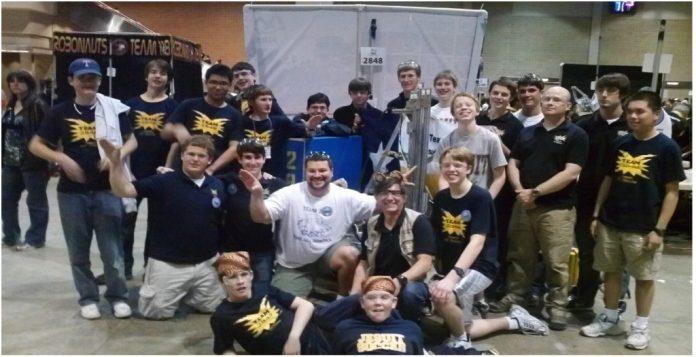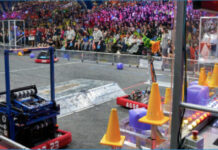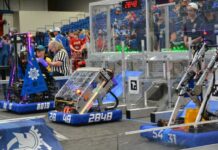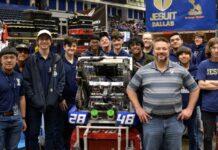Jesuit’s All-Sparks Robotics Team looked to make a deep run in regional robotics competitions this year. After strong performances in San Antonio and New Orleans tourneys, where the Jesuit All- Sparks Robotics Team made it to the semifinals and quarterfinals, respectively, the club continued its string of successes with another impressive performance at the FIRST Robotics Competition at the Dallas Convention Center on April 3. The competition featured teams from all over the Southwest, including a team from Mexico.
For more on the FIRST competition, see Will Wood’s article: https://jesuitroundup.org/?p=7254
As in prior tournaments, the objective was simple: to score as many basketball shots as possible. Appropriately named “Rebound Rumble,” the game took place on a 27-by-54 ft. court. Competing teams of engineers operated their three robots from behind walls on opposite sides of the court. On each alliance wall were four scoring hoops, positioned at three different heights, and across the middle of the court extended a low barrier where three bridges were stationed.
The bridges, which could be tilted at angles by mission control, were used by the robot alliances to cross from side to side. And with reflective vision targets above each hoop, the robots could easily track the baskets and shoot from anywhere on the floor.
The game began with a brief hybrid period, during which teams shot the compact foam basketballs with pre-programmed instructions; all baskets made during this time counted for three points. In real tournament play, baskets were worth between one and three points depending on the height of the hoop.
After the hybrid session, team players took over the controls and tried to score as many baskets as quickly as possible with their robots. While they could shoot unobstructed at the top of the key, the shooting robots had to deal with defending opponent robots everywhere else on the court.
Finally, near the end of the game, robot alliances could earn extra points by balancing two or even three robots on the bridges across the barrier.
With high expectations, the All-Sparks hoped to at least match their prior performances and possibly win the entire tournament. Although the team seemed excited and optimistic about their chances, they quickly found that there were “two robots better [than the All-Sparks robot] just like always,” as Jeff Barone ’13 remarked.
Having utilizing computer-aided design for the first year, which helped them manufacture specific robotic parts, the All-Sparks felt confident about their robot, Bonnie, as they ventured into unknown territory, but clearly the other teams “came prepared” which “obviously made the competition harder,” as Will Harris ’12 noted.
To their initial dismay, the All-Sparks did not win the tournament, reaching the semifinals before they ultimately fell. However, neither moderator and math teacher Michael Couvilion nor the robotics team members seemed unhappy or upset after the initial disappointment. “It really is just all about enjoying the process, the building and solving problems, and not fixating too much on winning. I am really proud of our guys: they acted as a team, played together and they should be proud of how they acted,” said Mr. Couvilion.
And despite their loss, Trey Curran ’13 believes that there “really is a lot of randomness in the tournament and lots of unknowns, but we played well so we were all satisfied.”
From the multitude of jubilant, mid-jump photos of the robotics teammates and Mr. Couvilion’s pride about his team’s cooperation and genuine enjoyment of robotics, it is clear that the competitions were merely the end of an exciting journey rather than the primary purpose of building robots. However, there was plenty of winning involved in the 2011-2012 season for the All-Sparks, with one quarter-finals and two semi-finals appearances. With their season ending on a high note at the convention center, Mr. Couvilion believes that if they can just keep “enjoying robotics,” a successful 2012-2013 season will be assured.






